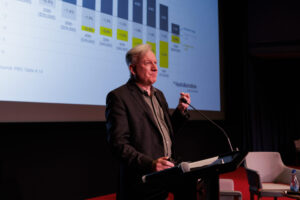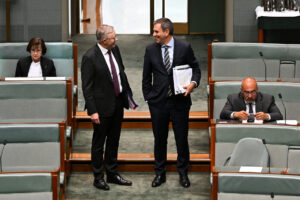by Richard Denniss
[Originally published in the Australian Financial Review, 26 June 2020]
The Australian Government is, by any measure, significantly under leveraged. The Commonwealth Government’s lazy balance sheet and its underspending on productivity boosting services like preventative health, childcare and environmental protection will harm Australia’s prosperity for decades to come. BHP has been in debt for 100 years and has no plans to repay it for the simple reason that its leadership are paid to discover projects with a higher rate of return than the record low interest rate. Any CEO who promised to ‘pay down debt’ to zero rather than invest in profitable new assets would be sacked on the spot. Finding those opportunities is their job.
When viewed in the context of Australia’s infrastructure—the decrepit state of so many schools and public buildings, and the embarrassing inefficiency of our cities’ public transport—the stingy response to the biggest economic downturn since the Great Depression makes as little financial sense as it does economic or political sense.
Last week, the Government announced $72 billion in ‘fast tracked’ infrastructure spending. The money, which will be spent over roughly 10 years, works out to less than $300 per resident per year. The average Australian probably spends more than that on coffee.
Even at its original cost, JobKeeper was not expensive in the scheme of things. In response to a once in a hundred-year pandemic, the Coalition announced a poorly targeted and bizarrely short-term $130 billion wage subsidy that excluded the most vulnerable workers yet was payable to priests and merchant bankers. At about $5,000 per resident it was never going to break the bank—or stave off recession. Its revised cost of less than $2,000 per resident makes it even more of a damp squib.
If the one-off cost of COVID-19 to the budget is a big deal, then what do we make of the $200 billion cost of building and operating Australia’s new submarine fleet? What about the $300 billion cost of personal income tax cuts locked-in for the next 10 years or the $400 billion of tax concessions for super over the same period? These policies never need to be ‘funded’, nor were Australians ever warned that these policies would burden future generations.
Having declared from Opposition that Australia faced a ‘budget emergency’ the Coalition went on to deliver six budget deficits in a row and deliver an increase in Commonwealth debt of more than $300 billion. The Coalition doubled the Commonwealth debt then promised a further $300 billion in tax cuts. Given a choice between lower debt or lower taxes, the Coalition never chooses lower debt.
And the Right is right to not worry about the size of our debt, provided they’re honest about it. At 20 percent of GDP, the Commonwealth debt is low by historic and international standards. Our debt to GDP ratio was over 100 percent at the end of World War II and it’s currently far below the OECD average of 83 percent.
But the weirdest thing about Australia’s ‘net public debt’ is what we have defined it to be the net of. When calculating our so called ‘net debt’ Australia literally ignores all the physical and intangible assets owned by the Commonwealth. Just as it would be ridiculous for BHP to focus purely on the money it owes and ignore the value of all of its mines, equipment and property, it is absurd to say we are impoverishing our children every time we build them a road, a school, a submarine or a wind turbine.
Australia is one of the richest countries in the world. Our GDP is about as large as Russia’s. Our debt is lower than it was for most of the 20th century through to the 1960s. And the Commonwealth just gave away $300 billion worth of revenue without a peep of complaint from those demanding they now ‘tighten their belt’ by giving less support to the unemployed.
Australia isn’t poor. It is rich beyond the comprehension of most humans who have ever lived. We can cut spending on the unemployed if we want to. And we can cut taxes for high income earners if we want to. But let’s stop pretending we have no choice.
Richard Denniss is chief economist at independent think tank The Australia Institute @RDNS_TAI
Between the Lines Newsletter
The biggest stories and the best analysis from the team at the Australia Institute, delivered to your inbox every fortnight.
You might also like
Stage 3 Better – Revenue Summit 2023
Presented to the Australia Institute’s Revenue Summit 2023, Greg Jericho’s address, “Stage 3 Better” outlines an exciting opportunity for the government to gain electoral ground and deliver better, fairer tax cuts for more Australians.
Richard Denniss: National Press Club Address
On Wednesday, 31 January 2024, Richard Denniss and Allegra Spender MP addressed the National Press Club for a debate on the Stage 3 tax reforms. **Check against delivery** [See below for transcripts] Tax is good. Tax is an investment in our society and the highest taxed countries in the world also happen to be the
RN Breakfast: Redesigning the Stage 3 Tax Cuts
Richard Denniss joins ABC RN Breakfast with Patricia Karvelas to discuss redesigning the Stage 3 tax cuts.



